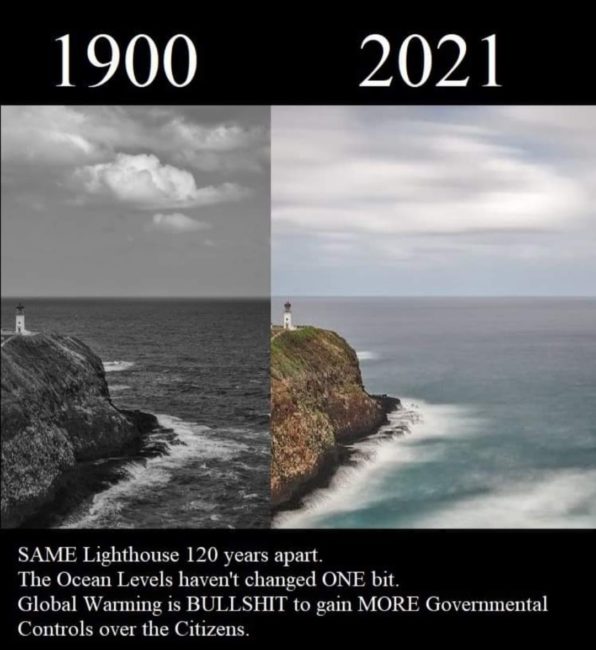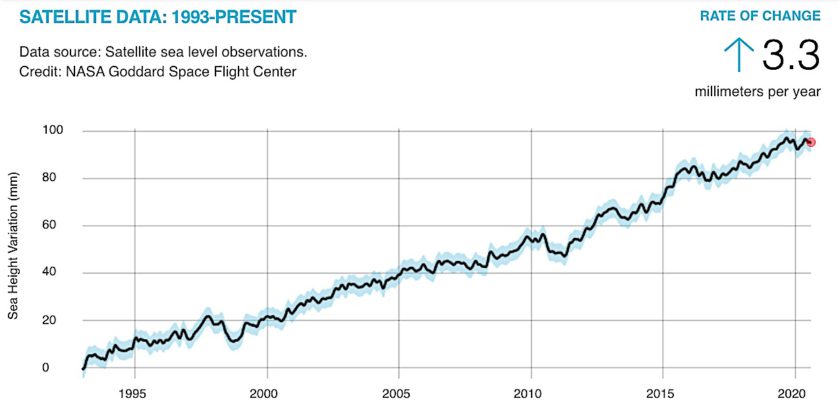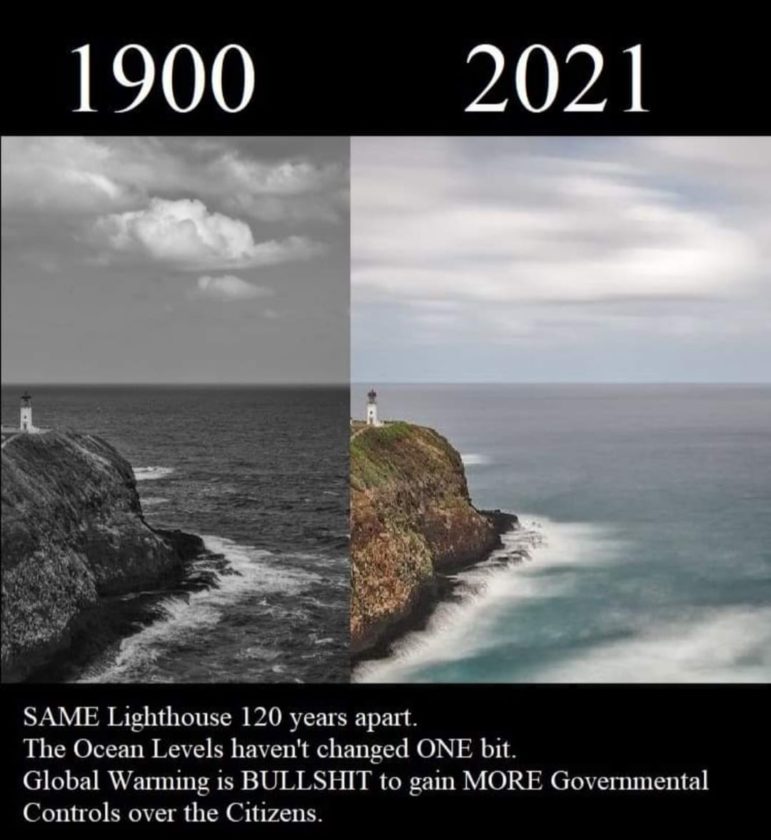
The picture above has appeared on Facebook a few days ago. The claim is that the image on the left, supposedly taken in 1900 shows more or less the same sea level as the image on the right. Since both have the same sea level, the leap then made is that since the sea level is not rising, Global Warming is a myth.
There are many many problems here.
What I’m not really doing is debunking yet another anti-science Facebook posting. Instead, let’s use this as a case study on how to think about claims when you are presented with them.
How should we evaluate such claims?
Can the facts be verified?
Once immediate thought is to wonder about the pictures themselves. We can ask, not just where, but when they were taken. Perhaps if we can identify where that is we might gain a clue. For the historical photo, verification that it really is from 1900 is also something to consider.
Let’s grab the URL for this image and meander on over to google image search to see what that tells us. Simply plug the URL in here.
We get an immediate hit.
That very quickly reveals that it is the Kīlauea Lighthouse in Hawaii. (See this image here from 2008). By comparing similar images of that specific lighthouse you can confirm it. One immediate and rather surprising revelation, via the Wikipedia page for that lighthouse, is that it was built in 1913. The claim that the picture was taken in 1900 is demonstrated to be an outright lie. That alone is sufficient to blow the credibility of the claim.
This is a case study on thinking about thinking, so we keep going.
So when was the picture on the left taken?
Cropped out but still just visible, is the tip of a building that can be seen in both images. What is that? It’s the visitor centre that was built in 1988. I can’t be 100% sure of that, but it sure looks like it. It is possible that it was the previous old radar building. That was built in 1929, so we can be very sure that the picture on the left is at least 1929, but possibly a lot newer.
Also of interest is the layout of the vegetation on the cliff face. From season to season this tends to change quite dramatically, but in both images it looks more or less the same. You can check that by googling images of Kīlauea Lighthouse and comparing just how different it can be.
I strongly suspect that what we have here is a black and white picture followed by a colour image taken from the exact same point at slightly different times on the exact same day.
What is also rather telling is that no source is cited for the supposedly “historical” picture. If you check google or the lighthouse website itself, do you find anything like it. No such historical image appears to actually exist.
Until the claimant cites credible evidence regarding the supposed age for any picture, then serious doubts should remain. The fact that nothing existed on the site in 1900 already verifies that the claimant is being deliberately deceitful, and on that basis alone, dismissal of this claim is wholly appropriate.
What else is wrong with the claim?
What other factors need to be considered for a claim?
If two things are being compared, then do those two things always remain the same, or is a variation possible, and so the comparison is actually meaningless.
The tide.
The claim is that sea level has not changed. As tides come and go, sea level will naturally vary over the course of a single day by many feet. You can see that here for this lighthouse.
What time were the images taken?
You could find an old picture taken at high tide, and then take a new one at low tide. You then declare, “Look, sea level is falling”. That of course would be a silly claim. The point is this. Unless you know exactly where in the tidal cycle the images were taken, then you have no way of conducting a meaningful comparison.
Is what is being presented a Meaningful way to actually establish the claim?
How much has sea level risen since 1900?
Even if you established that the two images were taken at the exact same point on the tidal variation, you still could not spot an 8 inch difference from where the images were taken.
To be honest, if you look at the supposedly newer image, it does in fact appear to be roughly about 8 inches higher, and so the images do actually appear to validate that sea level is rising. It’s an illusion of course. The image on the right has been through a filter. Such pictures are not an actual objective measurement at all, so can be dismissed as a means for establishing any claim.
How do we actually know that Sea level is rising?
What is the prevailing scientific consensus on whatever is being challenged?
Scientific research reveals things that are not only evidence-based, but have also been very carefully peer-reviewed to ensure that the conclusions are not wrong. If you dispute what it reveals, then your argument is not with an opinion or a belief. You are arguing against an objective understanding of reality that has been very carefully checked.
Measuring sea level might at first appear simple, but it is actually very complicated. You not only need to account for tidal variations, but you must also consider the movement of land itself. Over time land can rise or fall for geological reasons. A comprehensive conclusion needs to consider all the data and not just cherry-picked values that fit an existing conclusion.
To get a good understanding of the topic, a great place to start is with the Wikipedia article. It covers it really well.
To appreciate what is happening, below is a very accurate measurement for the years 1993 to 2021. It consists of data measurements taken via Satellite and covers the entire globe …

For roughly about 2,500 years sea level has been stable. This however is no longer the case.
Sea level is now rising, that is a well-established fact.
The rate at which it is rising is also accelerating, that is also a fact.
We understand why this is happening. We are burning fossil fuels and emitting greenhouse gases that create warming. Our window of opportunity to take meaningful action is still open, it is not yet a lost cause.
Anybody telling you that it is all a myth is pushing against the prevailing scientific consensus.
If faced with something like that, then your choice is this. Do you go with what the vast majority of scientific research is telling you, or do you instead opt for something that pushes back against that using some deeply dubious and highly emotive arguments?
In Summary
When faced with a claim, any claim, then consider asking yourself questions such as the following:
- Does what is being presented actually verify the claim or is there a simpler better explanation?
- In this case such pictures can’t verify or debunk an 8 inch difference, it is simply not a reliable way to do that.
- Is the evidence referenced so that you can actually independently verify it?
- A reference, just a URL, to an independent source for the historical picture, perhaps on a website that covers the history of the lighthouse would establish a date.
- The lack of anything should make you immediately suspicious
- It this case it is totally fraudulent. The claimed date of 1900 is not just misinformation, but deliberate disinformation that has been designed to deceive.
- For the claim, what is the prevailing consensus of the subject matter experts?
- In this case, no credible scientific source asserts that sea level is not rising
- To argue against this is to argue against a vast body of well-established evidence. It is perhaps akin to standing on the shoreline and telling the tide to stop rising.
If interesting in being right, then when faced with claims like this, dismissing it is your best bet.
Anybody making any claim needs to cite sufficient reliable evidence to verify it. If they can’t, or will not, then rejecting the claim is best. You have no responsibility at all to disprove what has not actually been proven, just dismiss it and move on.
